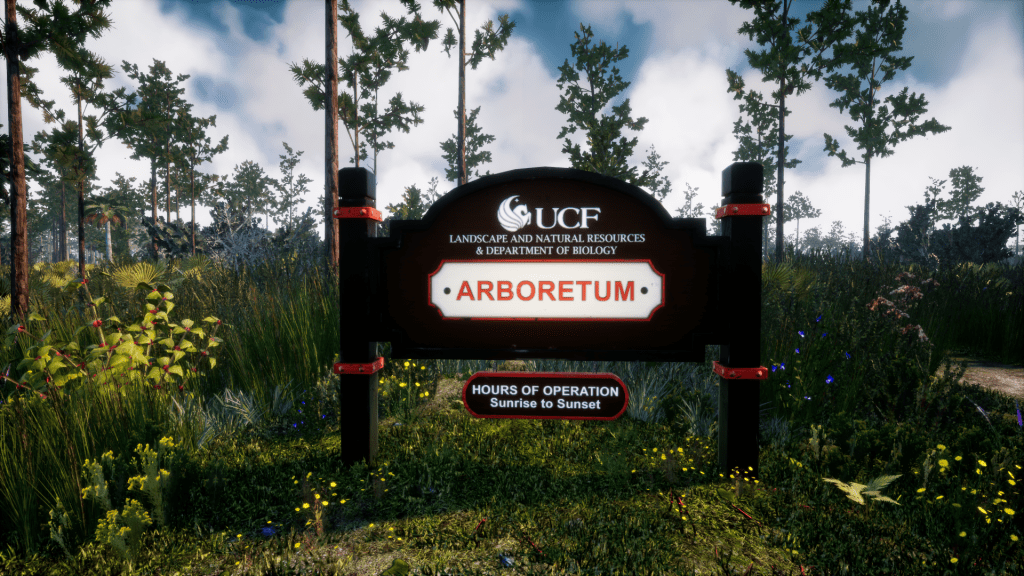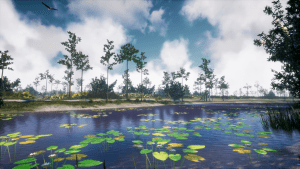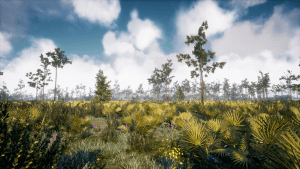Virtual Arboretum Visits Coming Soon

The vegetation is a familiar sight to Central Florida visitors: Sabal Palm, spiky Saw Palmettos, towering, Longleaf Pines and delicate, brightly colored flowers. But visitors to this version of the Florida lands bordering UCF’s campus will notice a couple things missing, including humidity and pesky bug bites.
That’s because these 247 acres exist on the computer of artist Maria Harrington, Ph.D., an assistant professor of digital media in the Nicholson School of Communication and Media and director of the Harrington Lab, which developed the collaborative project.
The Virtual UCF Arboretum is a true-to-life rendering of UCF’s wildlands that users can freely navigate through virtual reality or a computer. It was built based on data (the ratio of lily pads in a 10-square-meter plot of water, for instance), drone mapping (for the exact individual placement of those lily pads), and photographs used to create 3D models of high botanical accuracy. The attention to detail extends all the way to using the correct frog sounds and the texture of the butterfly wings.
More than a work of art or a virtual field trip, the Virtual UCF Arboretum could improve health and wellbeing, from space travel to treating hospital patients.
“It is virtual nature, but it’s also an interactive, digital artifact,” Harrington said. “No one has modeled such a large natural environment before with such accuracy.”

The Virtual Arboretum blends photos, data sets and drone footage for stunning images.
That “large environment” includes ten unique groupings of vegetation within the Arboretum, including the depression marsh, cypress dome, and scrub. Within those environments are 35 interactive plants users can select for detailed descriptions. Harrington sees this as an excellent future tool to complement real field trips.
Harrington also presented about the possibility of using virtual environments during space travel at the 2018 NASA Human Research Program Investigators’ Workshop HRP Research: The Gateway to Mars. Just as a zero-gravity environment requires astronauts to physically work out, the mind also needs to be exercised. These hyper-realistic environments could be paired with the smell of grass to recreate the sights, sounds and smells of visiting home.
Virtual nature environments hold potential in the treatment and care of medical patients. Early research has shown, for example, that burn patients experience less pain during wound care when immersed in a virtual Arctic world. Harrington sees potential for these types of worlds to stimulate the minds of bedridden patients, for instance, or helping people with dementia.
“Now that we’ve proved our creative concept viable, we can pursue multiple innovative research directions,” Harrington said. “It is a very exciting time at UCF.”

The Harrington Lab spent months creating exact replicas of plants.
The Virtual UCF Arboretum will be publicly available in early 2019 as an Unreal game level and a VR application. The complementary educational website, with AR and VR plant models was launched in October 2018, and is available here for free: https://arboretum.ucf.edu/virtual/ .
Special thanks and acknowledgement is due to the partners, collaborators, and team members involved. In particular, UCF undergraduates in The Harrington Lab: Kellie Beck, Zachary Bledsoe, Chris Jones, James Miller, and Thomas Pring, and the UCF Arboretum, under the direction of Patrick Bohlen, Ph.D., director of Landscape and Natural Resources and Arboretum, and staff: Jennifer Elliott, Ray Jarrett, Amanda Lindsay, John Guziejka and Rafael Pares.
